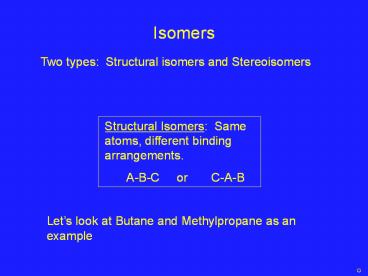Isomers - PowerPoint PPT Presentation
Title:
Isomers
Description:
Isomers Two types: Structural isomers and Stereoisomers Structural Isomers: Same atoms, different binding arrangements. A-B-C or C-A-B – PowerPoint PPT presentation
Number of Views:118
Avg rating:3.0/5.0
Title: Isomers
1
Isomers
Two types Structural isomers and Stereoisomers
?
2
Isomers Stereoisomers
Stereoisomers The molecules are connected the
same, but are arranged differently in space.
- There are 2 primary types of stereoisomers
- Geometrical Isomers The atoms on either side of
a bond are arranged differently - Optical Isomers The molecules are each others
non-superimposable mirror image
3
Geometrical Isomers
A clear dividing plane gives the molecule a top
half and a bottom half. If the arrangement of
atoms is the same on either side of this plane,
the molecule is the cis- isomer If the
arrangement is different, the molecule is the
trans- isomer
4
Geometrical Isomers
Are these molecules cis- or trans- ?
5
Optical Isomers
Go ahead and mentally rotate the molecules Do
the Blue and Red spheres line up? Its the same
as trying to superimpose your left and right hands
6
Properties of Alkanes
- Hydrocarbons are nonpolar
- The only intermolecular force between adjacent
hydrocarbons is the London Force - Methane through Butane are gases at room
temperature
7
Properties of Alkanes
- Long chain hydrocarbons have higher melting
points than branched chains with the same number
of carbons - Fatty acids in cell membranes take advantage of
this to make themselves more fluid
8
Properties of Alkanes
- Parrafins are what alkanes were once called and
youll sometimes hear the term used today - Means Little Affinity
- They got this name because they do not react
with - Strong Acids
- Strong Bases
- Oxidizing Agents
- Why?
- The bond enthalpies of the C-C and C-H bonds are
so high - Alkanes WILL undergo 2 types of reactions
- Combustion
- Substitution Some atom (say a halide) replaces
a hydrogen on the hydrocarbon
9
Properties of Alkenes
- The C-C double bond is more reactive than a
single C-C bond - The electron density is more exposed above and
below the plane of the molecule - The atoms cant spin around the sigma bond
- The double bond prevents molecules from packing
as tightly - Lower melting points than similar alkanes
10
How do we make an Alkene?
- Elimination Reaction
11
Aromatic Compounds
- Aromatic compounds are structurally based on the
benzene ring - They are called Arenes
- Aromatic alkene
- Typically responsible for odors
12
Nomenclature of Arenes
- Well start with benzene, C6H6
- When benzene is a substituent, it is called a
phenyl- group - We can use the number based system for naming the
linear hydrocarbons - Or
- We can use an older system to describe the
position of 2 substituents relative to each other
13
Nomenclature of Arenes
- The positions of the benzene ring have unique
names when dealing with 2 or more substituents - Ortho Substituents are at positions 1 and 2
- Meta Substituents are at positions 1 and 3
- Para Substituents are at positions 1 and 4
- Examples Dr. Hurlbert?
14
Chapter 19 Organic Chemistry II
15
Haloalkanes
- A Haloalkane is an alkane that has had one of the
hydrogens removed and replaced by a halogen atom - Also called Alkyl halides
- Properties
- Polar molecules
- Other molecules with electron rich atoms (like
oxygen) may attack the electron deficient carbon
16
Alcohols
- When we put a hydroxyl substituent (-OH) onto an
organic compound, we form an alcohol - As long as that organic compound isnt benzene or
the carbon isnt a carbonyl carbon - Alcohols are named by adding the ol suffix to
the base name
?
17
Alcohols
- Alcohols are liquids at room temperature
- This is due to the hydrogen bonding capabilities
given to them by the hydroxyl group - Low molecular mass alcohols (methanol, ethanol,
propanol) are soluble in water - Butanol and higher mass alcohols arent
- Why?
18
Ethers
- Who has heard of ethers before?
- Used to be used as anaesthetics
- Ethers have the formula R-O-R
- Where R is an alkyl group
- The Rs dont have to be the same
- We can think of ethers as the next progression in
moving from water to ethanol to ETHERS - H-O-H ? CH3CH2-O-H ? CH3CH2-O-CH2CH3
19
Ethers
- Do not form hydrogen bonds. Why?
20
Ethers
- Are not very reactive
- Not very polar
- Flammable!!
- Over time, will form peroxides that will explode
at the slightest energy input
21
Phenols
- A Phenol is a compounds with a hydroxyl group
attached to an aromatic ring - Unlike non-aromatic alcohols, phenols are weak
acids, WHY? (Dr. H will draw something here) - Putting something in the way of the ring and the
alcohol oxygen prevents the alcohol proton from
becoming acidic




















![Identification of Stereochemical Isomers of [Mo(CO)4(L)2] by Infra-Red Spectroscopy PowerPoint PPT Presentation](https://s3.amazonaws.com/images.powershow.com/7847007.th0.jpg?_=201605250912)










